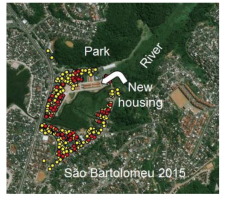当前位置:
X-MOL 学术
›
Int. J. Parasitol.
›
论文详情
Our official English website, www.x-mol.net, welcomes your
feedback! (Note: you will need to create a separate account there.)
The changing profile of schistosomiasis in a changing urban landscape.
International Journal for Parasitology ( IF 3.7 ) Pub Date : 2019-11-27 , DOI: 10.1016/j.ijpara.2019.10.003 Luciano K Silva 1 , Lúcio M Barbosa 2 , Jeffrey D Kovach 3 , Rogério Dos Santos Teixeira 4 , Ênio Silva Soares 4 , Cristiane Wanderley Cardoso 4 , Rosângela Vasconcelos Martins Marques 5 , Tatiane Pereira Dos Santos 5 , Mitermayer G Reis 6 , Ronald E Blanton 3
International Journal for Parasitology ( IF 3.7 ) Pub Date : 2019-11-27 , DOI: 10.1016/j.ijpara.2019.10.003 Luciano K Silva 1 , Lúcio M Barbosa 2 , Jeffrey D Kovach 3 , Rogério Dos Santos Teixeira 4 , Ênio Silva Soares 4 , Cristiane Wanderley Cardoso 4 , Rosângela Vasconcelos Martins Marques 5 , Tatiane Pereira Dos Santos 5 , Mitermayer G Reis 6 , Ronald E Blanton 3
Affiliation

|
Since 2007, most of humanity resides in urban areas, a trend which continues worldwide. Diseases usually associated with rural contexts are now emerging or newly recognised in cities. In the neighbourhood of São Bartolomeu in Salvador, Brazil, the prevalence of Schistosoma mansoni infection in 2011 was >20%. Following enrollment and treatment of a portion of the community, ~25% of the area underwent urban renewal. In 2015, we returned to enrol individuals who had previously participated and a cohort that had not taken part in 2011. Thus, infected individuals in one group experienced specific drug treatment plus improved living conditions and the second group only improved living conditions. Between 2011 and 2015 there were no organised treatment programs, but adequate sanitation increased from 69% to 92% coverage, household flooding decreased, and the presence of indoor toilets increased to 99% of households. Ownership of household appliances also increased significantly. The overall prevalence of schistosome infections was 6.2%. In 2015, the cohort first seen in 2011 had a higher prevalence (8.7%) than those first seen in 2015 (4.8%) and showed a few demographic differences. The 2011 cohort was older, more likely born in Salvador, less likely to have lived outside of Salvador, spent a greater percentage of their lifetime in Salvador, but more likely to have travelled. The population structure of the parasites from both cohorts underwent a marked change with similar increased component and infrapopulation differentiation and >10 fold decrease in effective population size. There was a 4-5 year shift in age-specific prevalence in 2015 for all compared with 2011. While praziquantel may have helped reduce prevalence, our evidence suggests that the structural changes and improvements in living conditions had the biggest impact on schistosomiasis in this community.
中文翻译:

在不断变化的城市景观中,血吸虫病的分布在不断变化。
自2007年以来,大多数人类居住在城市地区,这一趋势在全球范围内持续存在。通常与农村环境相关的疾病现在正在城市中出现或被新发现。在巴西萨尔瓦多的圣巴托洛缪附近,2011年曼氏血吸虫感染的患病率> 20%。在对一部分社区进行登记和治疗后,约25%的地区进行了城市更新。在2015年,我们重新招募了以前参加过研究的患者,而2011年没有参加研究的队列。因此,一组中的感染者经历了特殊的药物治疗并改善了生活条件,而第二组仅改善了生活条件。在2011年至2015年之间,没有有组织的治疗计划,但适当的卫生设施从69%增至92%,家庭洪水减少,室内厕所的使用率上升到了99%的家庭。家用电器的所有权也显着增加。血吸虫感染的总患病率为6.2%。2015年,2011年首次出现的队列患病率(8.7%)高于2015年首次出现的队列(4.8%),并显示出一些人口统计学差异。2011年的队列年龄较大,更有可能出生在萨尔瓦多,不太可能住在萨尔瓦多以外,他们一生中的大部分时间都在萨尔瓦多度过,但旅行的可能性更大。两个队列中的寄生虫的种群结构均发生了显着变化,其组成和种群分化相似,有效种群数量减少了10倍以上。与2011年相比,2015年所有人的特定年龄段患病率发生了4-5年的变化。
更新日期:2019-11-28
中文翻译:

在不断变化的城市景观中,血吸虫病的分布在不断变化。
自2007年以来,大多数人类居住在城市地区,这一趋势在全球范围内持续存在。通常与农村环境相关的疾病现在正在城市中出现或被新发现。在巴西萨尔瓦多的圣巴托洛缪附近,2011年曼氏血吸虫感染的患病率> 20%。在对一部分社区进行登记和治疗后,约25%的地区进行了城市更新。在2015年,我们重新招募了以前参加过研究的患者,而2011年没有参加研究的队列。因此,一组中的感染者经历了特殊的药物治疗并改善了生活条件,而第二组仅改善了生活条件。在2011年至2015年之间,没有有组织的治疗计划,但适当的卫生设施从69%增至92%,家庭洪水减少,室内厕所的使用率上升到了99%的家庭。家用电器的所有权也显着增加。血吸虫感染的总患病率为6.2%。2015年,2011年首次出现的队列患病率(8.7%)高于2015年首次出现的队列(4.8%),并显示出一些人口统计学差异。2011年的队列年龄较大,更有可能出生在萨尔瓦多,不太可能住在萨尔瓦多以外,他们一生中的大部分时间都在萨尔瓦多度过,但旅行的可能性更大。两个队列中的寄生虫的种群结构均发生了显着变化,其组成和种群分化相似,有效种群数量减少了10倍以上。与2011年相比,2015年所有人的特定年龄段患病率发生了4-5年的变化。











































 京公网安备 11010802027423号
京公网安备 11010802027423号